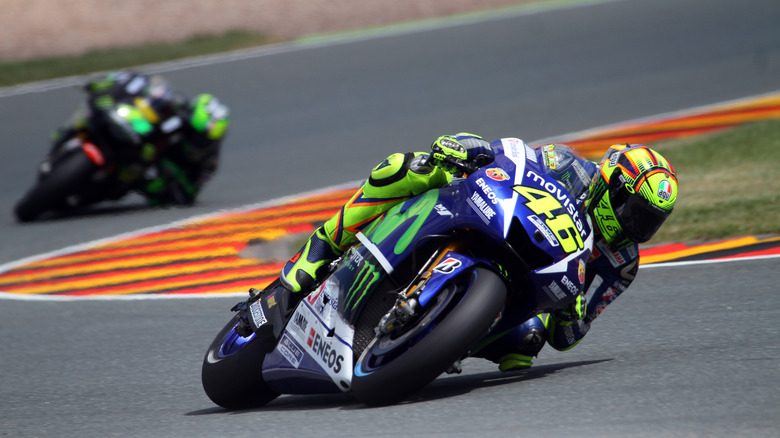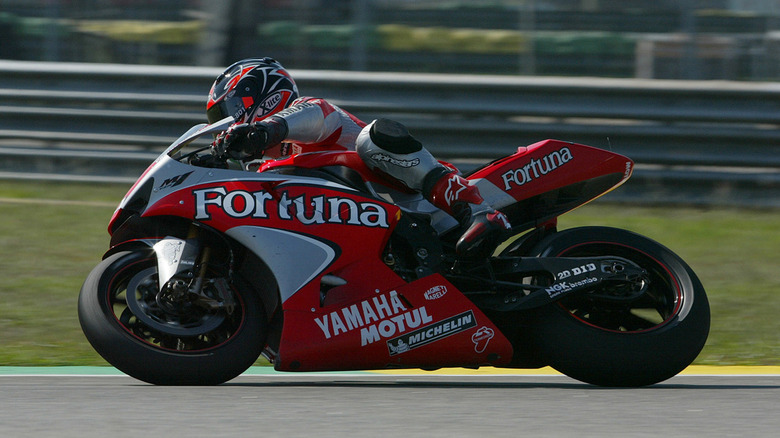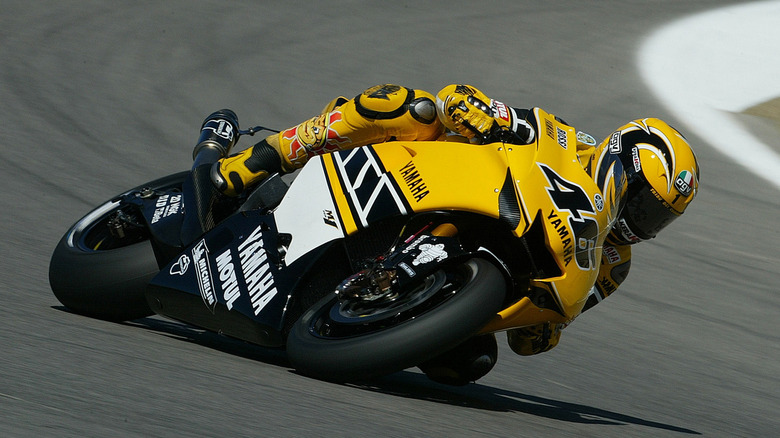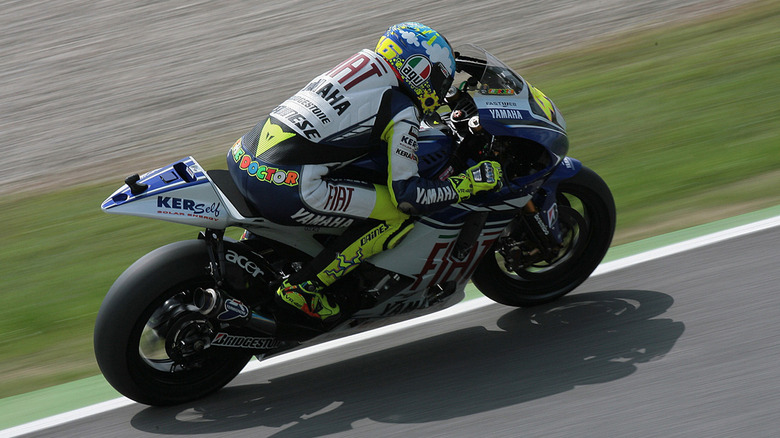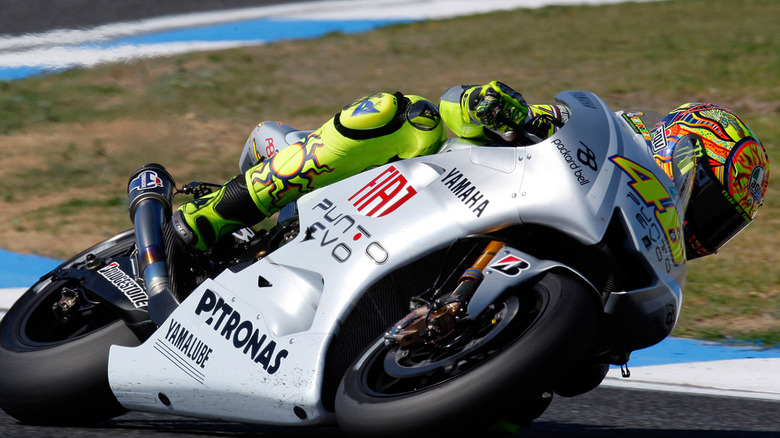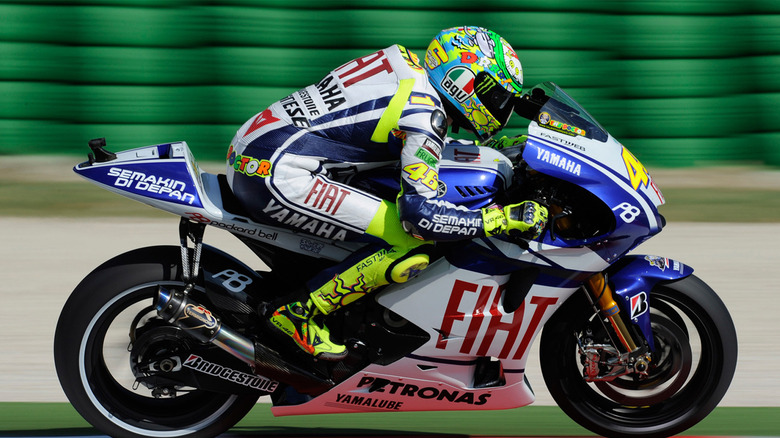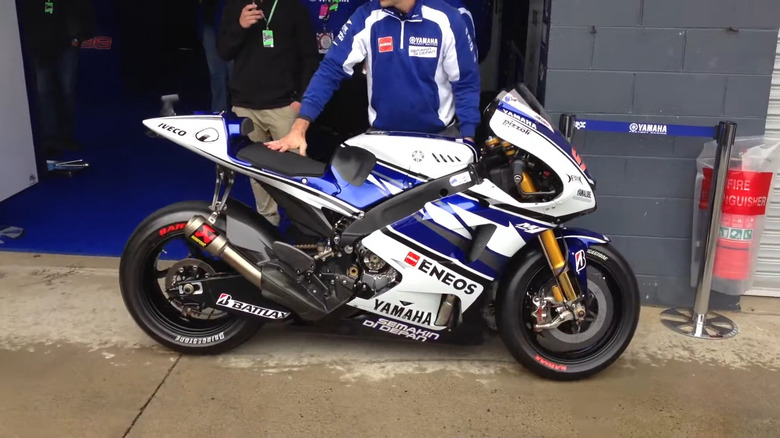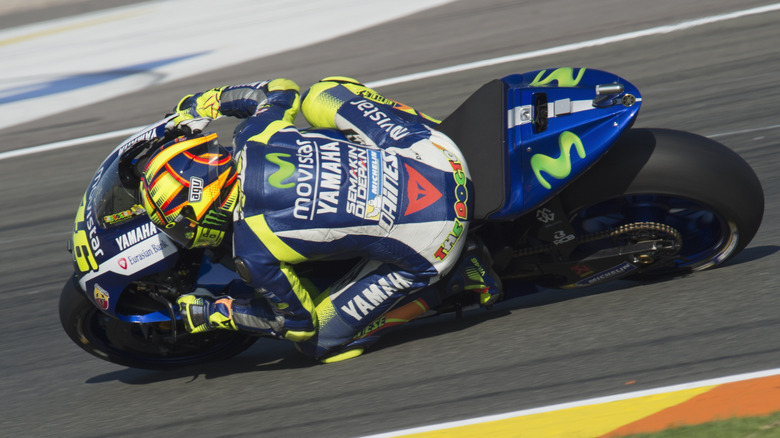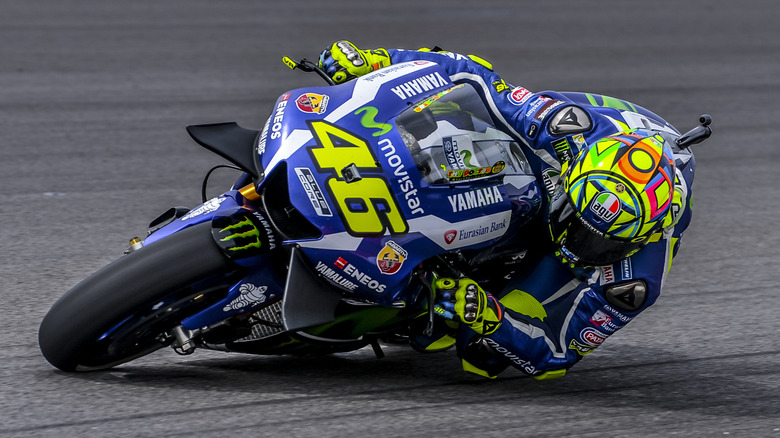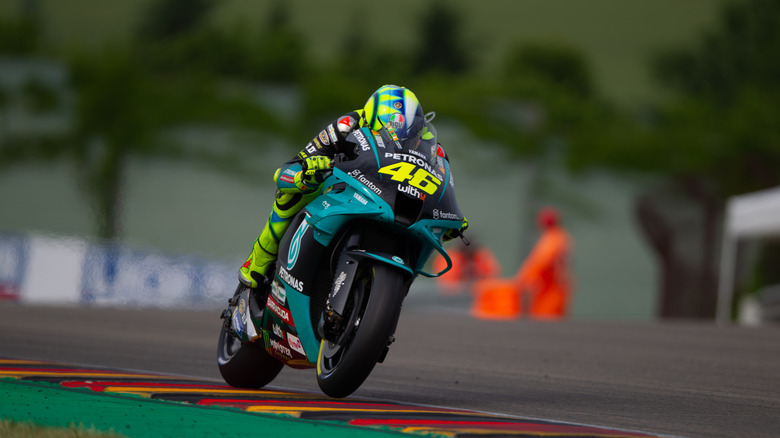9 Times Yamaha Motorcycle Racing Team Took Home MotoGP Championships
Formula One has Ferrari. Nascar has Chevrolet. Every motorsport series has manufacturers that are synonymous with the sport itself, and very few brands can compete with the legacy of Yamaha in the world of motorcycle racing. Competing in its first season in what was called the 500cc class at the time in 1973, the company very quickly made its mark by winning the constructors' championship in 1974. Legendary rider Giacomo Agostini would win the riders' title the following year for the first time with the team. Also referred to as GP500 toward the end of the 500cc run, Yamaha won a total of nine constructors' titles during this era of road racing, along with 10 riders' championships.
In 2002, the pinnacle of two-wheeled motorsport underwent huge changes, ditching 500cc units for larger 990cc engines and becoming MotoGP as we know it today. Unsurprisingly, Yamaha remained a key manufacturer during and after the transition, competing with the likes of Honda from the get-go. With even more of the greatest riders in the history of the sport on the saddles of its bikes, here are the nine years when Yamaha Factory Racing took home at least one of the three championships in the MotoGP class.
2004: Riders' and Teams' Championships
Yamaha's first championship-winning MotoGP year came just two years after the event's major change, in 2004. The transition to four-stroke engines hadn't been the smoothest, which led to Yamaha coming second in the teams' championship in 2002 and fifth in 2003. However, signing Valentino Rossi changed course for the Japanese brand drastically. The man who would start the trend of MotoGP racers sticking their legs out had already won the riders' title in 2001, 2002, and 2003, and he proved incredibly useful for fixing Yamaha's woes from the previous seasons.
Alongside his natural ability on two wheels (now four in the WEC), he made some crucial decisions for the YZR-M1 bike moving into the 2004 season. Yamaha offered four different engine configurations to choose from, ultimately going for the four-valve crossplane crankshaft, giving the bike the best balance and power delivery. Considering how unstable the team's motorcycle was in the years prior, this switch proved monumental for the future. With a new engine, the engineers also revised the chassis to suit the four-valve M1 best, creating a package that could challenge frontrunners consistently.
By the end of the 2004 season, Valentino Rossi won a total of nine victories, giving him his fourth riders' championship in the premier class of road racing. The factory team also clinched the teams' championship by just seven points over Honda, though the latter managed to win the constructors' crown by 27 points.
2005: Riders', Teams', and Constructors' Championships
Moving into the 2005 season, Yamaha was riding on the momentum of its double title-winning season and hoping to at least repeat its success. The technical rule changes weren't anything major this year, with changes to fuel cooling rules being the only notable revision for the premier class. However, for the riders, the races would no longer be stopped for wet conditions, which presented new challenges in a motorsport series that was already the most dangerous. And yet, with major updates for the 2005 YZR-M1 for 2005 and Rossi still in the saddle, the team put on an even better display.
Yamaha made significant improvements to the M1 engine for 2005, redesigning multiple core components to make it smaller overall and achieve better mass centralization. Despite being more compact, the bore was increased, leading to a higher RPM limit for the bike, also changing the camshaft's drive mechanism to a gear type rather than the chain type used in prior years. Other improvements were found in the fuel tank, cooling, and frame design to further improve the balance of the YZR-M1.
After winning 11 out of the 17 races, Valentino Rossi won his second straight riders' title with Yamaha, with the team also winning the teams' championship again. To top it off, riders like Colin Edwards and Toni Elias helped Yamaha to win the constructors' championship, completing the triple crown of MotoGP.
2008: Riders', Teams', and Constructors' Championships
After winning the triple crown in 2005, Yamaha didn't manage to win any gold the following year. The factory team still won races, with Rossi achieving five victories overall, but that wasn't enough to three-peat the riders' title. He lost out by five points to Honda's Nicky Hayden. In 2007, the engine regulations changed from 990cc to 800cc for safety reasons, a switch that Ducati nailed and won all three championships convincingly with some of the fastest bikes it's ever built. The tables turned dramatically the following year, however, and Yamaha reigned supreme once more.
As Ducati struggled with stability issues, Yamaha's improvements allowed it to claw back the deficit and win MotoGP's triple crown once more. Most of Yamaha's focus for the 2008 season was on weight-saving and overall weight distribution, introducing new parts such as a pneumatic valve system that shaved off 40% of the prior system's weight. Pairing this with the improved aerodynamics for that year's YZR-M1, Valentino Rossi won the riders' championship by 93 points, with his new teammate in Jorge Lorenzo, finishing fourth. The teams' championship was won by 159 points over Honda, and the constructors' title by 81 points over Ducati. The triple crown was Yamaha's once more.
2009: Riders', Teams', and Constructors' Championships
Yamaha's success carried on into the 2009 season, but Rossi's teammate Lorenzo made some pretty impressive strides to close the gap to the reigning champion from Italy. 2009 saw more changes to the regulations, with the most prominent being Bridgestone becoming the only tire supplier for all teams. Before it was Bridgestone and Michelin, with Rossi already using the former supplier. Lorenzo had to adapt to the Bridgestones after using Michelin before 2009, but he managed to win four races over the season compared to Rossi's six wins.
As a result, Rossi won his seventh championship in the premier series of motorcycle road racing, which would also be his last. Lorenzo trailed by 45 points, with Honda's Pedrosa and Ducati's Stoner also not far behind. As for the YZR-M1, Yamaha didn't make any significant changes to the bike, rather refining the improvements made for 2008 and getting a better weight distribution and cooling overall. The total number of engines allowed across the season per rider was also decreased, leading to Yamaha focusing on the reliability of the engine. The triple crown was achieved once more, with the factory team winning the teams' championship and the Monster Tech 3 team helping Yamaha to wrap up the constructors' title three races before the season wrapped up.
2010: Riders', Teams', and Constructors' Championships
For the 2010 MotoGP season, the Grand Prix Commission made four-cylinder engines mandatory, which didn't cause a headache for Yamaha as the team was already using this configuration since the four-stroke era came into effect in 2002. What did cause a headache, however, was Valentino Rossi suffering a nasty crash during practice at the high-speed Mugello Circuit. The accident resulted in Rossi needing surgery on his fractured leg, missing four races toward the start of the season, and effectively ending his championship hopes for 2010.
Still, after a strong 2009 campaign, all was not lost for Yamaha, as Jorge Lorenzo made the most of his YZR-M1 to take a total of nine races, winning the championship by 138 points over Honda's Dani Pedrosa. Despite his crash, Rossi still managed to score solid points throughout the races he did compete in, reaching third in the riders' championship and helping the factory team secure the teams' championship once more. Driving for Monster Tech 3 team, 2010 rookie of the year Ben Spies had a great year with a couple of podium finishes, also earning Yamaha another constructors' championship to boot.
2012: Riders' Championship
After Rossi's difficult 2010 season, he decided to leave Yamaha and join Ducati for the 2011 MotoGP campaign. Yamaha didn't feel the effect of the 2008 financial crisis's fallout quite as much as other teams like Kawasaki, but it was handed a major blow with its title sponsor, Fiat, departing the team as a result of Rossi's switch to Ducati. Still, Yamaha managed to remain competitive throughout 2011 with Lorenzo and Spies, coming second and fifth in the championship, respectively.
In 2012, however, with JX Nippon Oil and Energy as a new major sponsor, Lorenzo would bring the Japanese icon back to the top. After a title battle with Dani Pedrosa, Lorenzo took the riders' championship home with six wins, never finishing below second in the races where he managed to cross the finish line. This would be the only title that Yamaha won in 2012, with both the teams' and constructors' titles going to Honda.
The 2012 season saw big changes in the regulations, with the maximum capacity increased to 1,000cc and a new class for privateer teams to fill the empty slots left by teams that had to cut costs because of the '08 crisis. Yamaha's status allowed it to successfully enter a new era of performance in the top class of motorcycle racing, despite its own transition period behind the scenes.
2015: Riders', Teams', and Constructors' Championships
Unfortunately, Rossi's stint at Ducati didn't work out the way he hoped, and he failed to get close to the championship in either 2011 or 2012. As a result, he rejoined Yamaha in 2013, who were still competing at the front of the field consistently. Rossi and Lorenzo became teammates once more, and while Lorenzo got incredibly close to winning back-to-back rider's championships, Marc Marquez narrowly beat him by four points at the end of the season. Honda would also complete the triple crown that year, leaving Yamaha empty-handed for 2013. 2014 wasn't much better, with Honda once again taking all three titles by a larger margin.
2015 didn't see any major rule changes, but Yamaha, known as Moviestar Yamaha thanks to a new sponsor deal in 2014, managed to find a way to briefly halt Marquez's charge to the top of the road racing world. Honda struggled to find the balance it had in previous years, with Marquez having numerous crashes, leaving Rossi and Lorenzo to duke it out at the front throughout the season. Lorenzo would beat Rossi by five points, which subsequently gave Yamaha the triple crown by larger margins over the competition. The focus for the YZR-M1 bike for 2015 was corner entry and the introduction of a new seamless-shift gearbox, both of which gave the champion riders far more confidence in their machine.
2016: Teams' Championship
Yet another major change for the whole MotoGP field was introduced in 2015, with Michelin becoming the sole tire supplier to each team instead of Bridgestone. Unfortunately for Yamaha's factory team, the new tire proved difficult to figure out with the YZR-M1. Reliability was also an issue for the team, despite having what many considered to be the best package on the grid, carrying over from the highly successful 2015 season. Honda didn't have as much trouble.
Flipping the coin and now taking advantage of Yamaha's struggles, Marquez won his second MotoGP championship by 49 points, with Rossi and Lorenzo separated by 16 points in second and third. Honda clinched the constructors' championship by 14 points, a tough pill to swallow after a troubled season. All was not lost, however, with both Rossi and Lorenzo scoring more points consistently compared to the factory Honda team, winning the teams' championship by 28 points. Both riders also scored wins, so 2016 was still a success on paper, even if they couldn't carry on from 2015.
2021: Riders' Championship
After 2016, Marc Marquez would lead one of the most dominant periods in recent MotoGP history. He won the driver's title every year from 2016 to 2019, also giving Honda the triple crown between 2017 and 2019. Between those latter three years, Yamaha would end the seasons empty-handed, with riders Rossi and Vinales never really being genuine challengers to the Spaniard's reign. Franco Morbidelli almost won the 2020 riders' title on the customer Petronas SRT bike, but Yamaha were back to winning ways with Fabio Quartararo.
On the team side of the 2021 season, Vinales was dropped from the factory team mid-way through the campaign, replacing him with Morbidelli. Ducati's pairing was more consistent than what Yamaha had this year, giving the Italian outfit both the teams' and constructors' championships. However, Quartararo kept pumping in consistent results with five wins in total, taking the riders' title home for Monster Energy Yamaha by 26 points.
As of 2025, the Frenchman's title is the most recent championship win for Yamaha in MotoGP. He got close to winning again in 2022, but was overtaken by Bagnaia in the end. The last few years have been particularly challenging for Yamaha, struggling to remain consistent over an entire season to mount any sort of challenge to the likes of Ducati. At the time of writing, Yamaha is currently last in the constructors' championship this year, with a steep hill to climb with few races left of the season.
